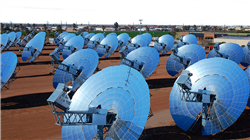University certificate
The world's largest faculty of engineering”
Description
Through this Postgraduate diploma, based on Relearning, you will efficiently select all the components of photovoltaic systems"

With growing concerns about climate change and the need to reduce dependence on fossil fuels, solar PV has become a key option for sustainable electricity generation. In this regard, engineers play a critical role in designing PV systems that are not only efficient and cost-effective, but also safe. For this reason, it is essential that these experts have a detailed overview of the PV system design process, ranging from site assessment or component selection to power system planning and integration with existing infrastructure.
In this context, TECH has created a pioneering and revolutionary Postgraduate diploma in Photovoltaic Installation Design. The academic itinerary will analyze the construction of large photovoltaic plants taking into account factors such as climate data, sizing of wiring or production parameters. The syllabus will also delve into the sizing of off-grid PV systems, including site selection, component selection and its corresponding coupling. At the same time, the program will provide students with state-of-the-art alarm issuing strategies. In this way, graduates will continuously monitor systems to correct problems before they significantly affect performance.
Because this program is developed through a 100% online methodology, engineers will have the opportunity to expand their learning without having to attend to cumbersome pre-established study schedules. In addition, TECH uses its ground-breaking method of Relearning, based on the repetition of key concepts of to correctly. In this way, professionals will enjoy a totally natural and progressive learning experience. All students will need is an electronic device with an Internet connection (such as a cell phone, computer or tablet) to log on to the Virtual Campus and embark on a high-intensity experience that will improve their career prospects considerably.
Handle surplus management at the world's best online university according to Forbes"
This Postgraduate diploma in Photovoltaic Installation Design contains the most complete and up-to-date scientific program on the market. The most important features include:
- The development of practical cases presented by experts in Photovoltaic Installation Design
- The graphic, schematic, and practical contents with which they are created, provide practical information on the disciplines that are essential for professional practice
- Practical exercises where self-assessment can be used to improve learning
- Its special emphasis on innovative methodologies
- Theoretical lessons, questions to the expert, debate forums on controversial topics, and individual reflection assignments
- Content that is accessible from any fixed or portable device with an Internet connection
You will delve into the safety of photovoltaic plants and ensure both worker protection and regulatory compliance"
The program’s teaching staff includes professionals from the sector who contribute their work experience to this program, as well as renowned specialists from leading societies and prestigious universities.
The multimedia content, developed with the latest educational technology, will provide the professional with situated and contextual learning, i.e., a simulated environment that will provide immersive education programmed to prepare for real situations.
This program is designed around Problem-Based Learning, whereby the professional must try to solve the different professional practice situations that arise during the course. For this purpose, the students will be assisted by an innovative interactive video system created by renowned and experienced experts.
Do you want to incorporate state-of-the-art sizing optimization strategies into your daily practice? Achieve it with this program in only 540 hours"

You will reach your academic goals quickly, without the need to travel to a study center thanks to TECH's 100% online methodology"
Syllabus
Through this program, engineers will master the fundamentals of solar energy. The syllabus will delve into the design of large photovoltaic plants, focusing on aspects such as topographic data, the sizing of components in AC/HV or the monitoring of variables. The syllabus will also delve into the phases involved in the design of a self-consumption photovoltaic installation from a technical point of view. In this way, graduates will optimize the orientation of the solar panels and maximize the collection of solar energy. In addition, the program will provide students the most innovative strategies for the optimization of sizing.

You will design Photovoltaic Installations for various applications, ensuring maximum efficiency and performance"
Module 1. Large Photovoltaic Plant Design
1.1. Climate and Topographic Data, Power, Other Data
1.1.1. Peak and/or Nominal Power
1.1.2. Climate and Topographic Data
1.1.3. Other Data: Required Floor Area, Access and Connection Network, Easements
1.2. Selection of the Photovoltaic Plant Layout
1.2.1. Analysis of Solar Tracking Systems
1.2.2. Topology of Inverters: Central or String
1.2.3. Alternative Uses: Agrivoltaics
1.3. Dimensioning of Components in DC
1.3.1. Solar Field Sizing
1.3.2. Solar Tracker Sizing
1.3.3. Wiring and Protection Sizing
1.4. AC/LV Component Sizing
1.4.1. Inverter Sizing
1.4.2. Other Elements: Monitoring, Control and Counters
1.4.3. Wiring and Protection Sizing
1.5. AC/HV Component Sizing
1.5.1. Transformers Sizing
1.5.2. Other Elements: Monitoring, Control and Counters
1.5.3. High-Voltage Wiring and Protection Sizing
1.6. Energy Yield Estimation
1.6.1. Daily, Monthly and Annual Yield
1.6.2. Production Parameters: Performance Ratio
1.6.3. Strategies for Sizing Optimization. Peak and Nominal Power Ratio
1.7. Monitoring of Variables
1.7.1. Identification of Variables to be Monitored
1.7.2. Strategies for Alarm Issuance
1.7.3. Alternative Monitoring and Alarms for the Photovoltaic Plant
1.8. Grid Integration
1.8.1. Electrical Quality
1.8.2. Grid Codes
1.8.3. Control Centers
1.9. Safety and Health of Photovoltaic Plants
1.9.1. Risk Analysis
1.9.2. Prevention Measures
1.9.3. Protection Measures
1.10. Examples of Photovoltaic Plant Design
1.10.1. Plant Design with Central and Fixed Inverter
1.10.2. Plant Design with Single-Phase Photovoltaic Module, with Inverter by String and Single-Axis Tracker
1.10.3. Plant Design with Bifacial Photovoltaic Module, with Inverter by String and Single-Axis Tracker
Module 2. Self-Consumption Photovoltaic Installation Design
2.1. Off-Grid and Self-Consumption Systems
2.1.1. Electricity Cost Structure. Fees
2.1.2. Climate Data
2.1.3. Restrictions: Urban Planning
2.2. Characterization of Demand Profiles
2.2.1. Electrification of Demand
2.2.2. Profile Modification Alternatives
2.2.3. Estimation of the Design Demand Profile
2.3. Site Selection and Layout
2.3.1. Restrictions: Exterior Surfaces, Slopes, Orientations, Accessibility
2.3.2. Surplus Management. Virtual or Real Battery, Diversion to Equipment.
2.3.3. Selection of the Installation Scheme
2.4. Solar Field Tilt and Orientation
2.4.1. Optimal Tilt of the Solar Field
2.4.2. Optimal Orientation of the Solar Field
2.4.3. Management of Multiple Tilt/Orientation
2.5. Components Sizing in DC
2.5.1. Solar Field Sizing
2.5.2. Solar Tracker Sizing
2.5.3. Wiring and Protection Sizing
2.6. AC Component Sizing
2.6.1. Inverter Sizing
2.6.2. Other Elements: Monitoring, Control and Counters
2.6.3. Wiring and Protection Sizing
2.7. Energy Yield Estimation
2.7.1. Daily, Monthly and Annual Yield
2.7.2. Production Parameters: Self-Consumption, Surplus
2.7.3. Strategies for Sizing Optimization. Peak and Nominal Power Ratio
2.8. Coverage of Demand
2.8.1. Demand Classification: Fixed and Variable
2.8.2. Demand Management
2.8.3. Demand Coverage Ratios. Optimization
2.9. Surplus Management
2.9.1. Surplus Appraisal
2.9.2. Derivation of Surplus to Real or Virtual Storage
2.9.3. Derivation of Surplus to Regulated Loads
2.10. Design Examples of Self-Consumption Photovoltaic Installations
2.10.1. Design of Individual Self-Consumption Photovoltaic Installation, with Surplus and without Batteries
2.10.2. Design of Individual Self-Consumption Photovoltaic Installation, with Surplus and with Batteries
2.10.3. Design of a Collective Self-Consumption Photovoltaic Installation, without Surplus
Module 3. Off-Grid Photovoltaic Installation Design
3.1. Context and Applications of On-Grid Photovoltaic Installations
3.1.1. Energy Supply Alternatives
3.1.2. Social Aspects
3.1.3. Applications
3.2. Characterization of the Demand of On-Grid Photovoltaic Installations
3.2.1. Demand Profiles
3.2.2. Service Quality Requirements
3.2.3. Continuity of Supply
3.3. Settings and Layout of Off-Grid Photovoltaic Installations
3.3.1. Location
3.3.2. Settings
3.3.3. Detailed Schemes
3.4. Component Functionalities of Off-Grid Photovoltaic Installations
3.4.1. Generation, Storage, Control
3.4.2. Conversion, Monitoring
3.4.3. Management and Consumption
3.5. Component Sizing of Off-Grid Photovoltaic Installations
3.5.1. Solar Generator-Accumulator-Inverter Sizing
3.5.2. Battery Sizing
3.5.3. Sizing of Other Components
3.6. Energy Yield Estimation
3.6.1. Solar Generator Production
3.6.2. Storage
3.6.3. End-Use Production
3.7. Coverage of Demand
3.7.1. Solar Photovoltaic Coverage
3.7.2. Auxiliary Generator Coverage
3.7.3. Energy Losses
3.8. Demand Management
3.8.1. Demand Characterization
3.8.2. Demand Modification. Variable Loads
3.8.3. Demand Substitution
3.9. Specifications for DC and AC Pumping Installations
3.9.1. Storage Alternatives
3.9.2. Coupling of Motor- Pump- photovoltaic Generator Group
3.9.3. Water Pumping Market
3.10. Design Examples for Stand-Alone Photovoltaic Installations
3.10.1. Photovoltaic Installation Design for an Individual Off-Grid House
3.10.2. Photovoltaic Installation Design for Community Off-Grid Houses
3.10.3. Photovoltaic Installation Design and Generator Set for an Individual Off-Grid House

A unique, key and decisive educational experience that will boost your professional development as a Photovoltaic Engineer. Enroll now!"
Postgraduate Diploma in Photovoltaic Installation Design
This Postgraduate Diploma in Photovoltaic Installation Design developed by TECH Global University offers specialized and advanced education to address the world of solar energy and the practical applications of this technology. This program, taught 100% online, will provide you with the skills and knowledge necessary to design, plan and implement efficient and sustainable photovoltaic systems, contributing to the transition to a cleaner energy future. Here, you will explore the fundamentals of solar PV, starting with a solid understanding of semiconductor physics and solar cell operation. As you progress, you'll be introduced to the various PV technologies available, including monocrystalline, polycrystalline and thin-film modules. This technical knowledge is essential for selecting the right components and optimizing the performance of photovoltaic installations. You will also address the design and sizing of photovoltaic systems. You will learn how to use specialized software and simulation tools to create accurate designs that maximize solar energy collection. Finally, you will address crucial aspects such as panel orientation and tilt, shading and module interconnection, ensuring that designs are both efficient and feasible in practical terms.
Become a specialist in the design of photovoltaic installations
La modalidad online del curso ofrece una flexibilidad invaluable, que te permitirá acceder a los materiales de estudio desde cualquier lugar y a cualquier hora, fomentando un aprendizaje autodirigido que se adapta a tus horarios y compromisos diarios. Un componente clave del curso es la planificación y gestión de proyectos fotovoltaicos. Adquirirás habilidades en la evaluación de recursos solares, análisis de viabilidad económica y estrategias de financiación, permitiéndote desarrollar proyectos que no solo sean técnicamente sólidos, sino también rentables y sostenibles. Esta capacitación integral te prepara para enfrentar los desafíos asociados con la implementación de sistemas fotovoltaicos en una variedad de contextos, desde instalaciones residenciales, hasta grandes parques solares. Al finalizar, estarás preparado para asumir roles especializados en el sector de la energía solar. Podrás trabajar en empresas de ingeniería, consultorías energéticas, organizaciones gubernamentales y ONG, contribuyendo al diseño y desarrollo de proyectos solares innovadores y sostenibles. ¡Inscríbete ya y da un paso decisivo hacia una carrera en el sector de las energías renovables! Podrás contribuir al desarrollo de un futuro energético más sostenible.







